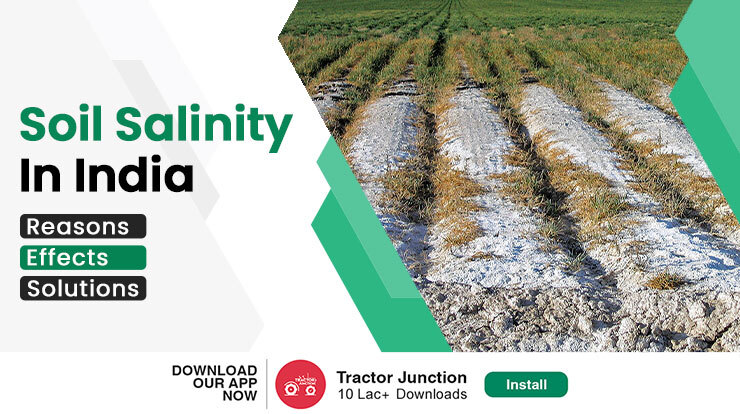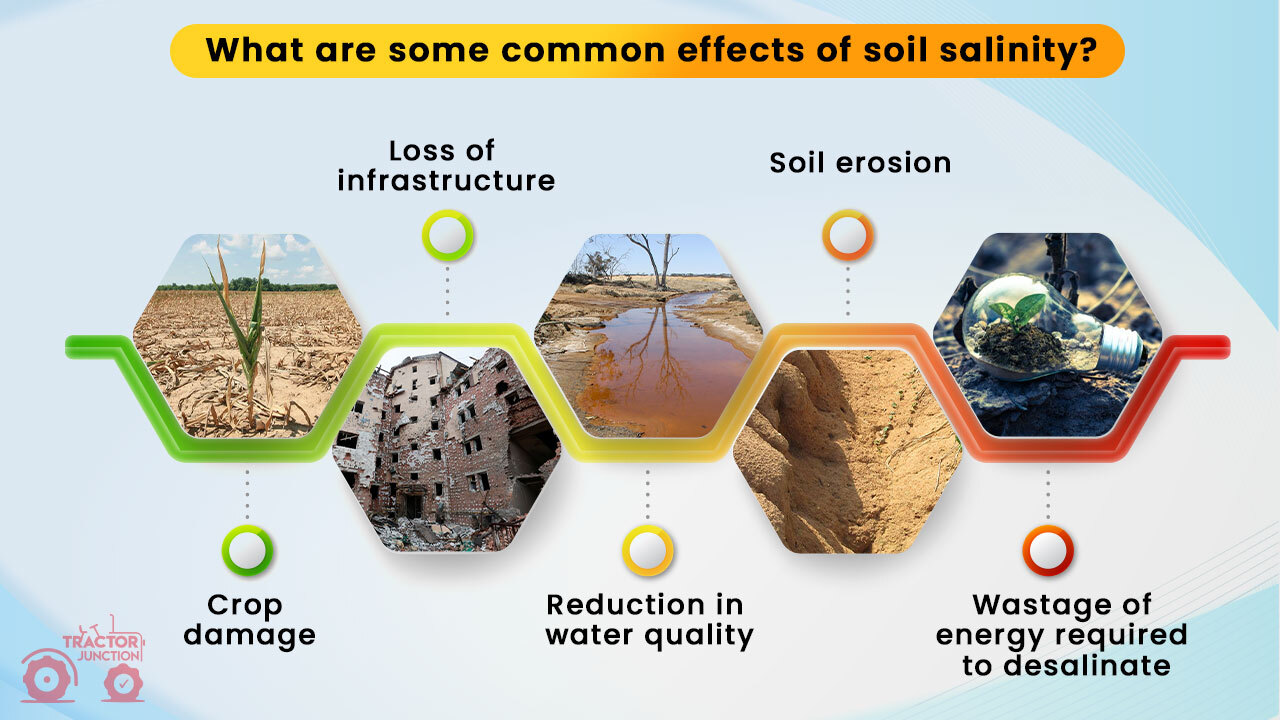
Soil and its fertility are getting depleted day by day due to various reasons such as soil erosion, deforestation, soil salinity, soil acidity, etc. factors. Due to the above reasons, the earth will sooner or later run out of food as with the growing population. The recent save soil campaign by famous preacher Sadhguru was all about it. Talking about soil salinity in India, it is becoming one of the prime causes of soil degradation and infertility.
In this blog, we will discuss soil salinity in India, its prime causes, effects and the solutions to the problem. Let us now dive into details.
What is soil salinity, and what are the reasons behind it?
Soil salinity is the presence of saline salts in the soil. Although soil salinity is a natural process as observed by most environmentalists. It can also be brought by artificial causes like irrigation and road construction.
Soil salinity in India is not a very rare phenomenon. It is a natural phenomenon where soluble salts of ions like Sodium, Potassium, Calcium, and Chlorine accumulate in the soil. In areas of high precipitation, they have washed away. While dry areas are more prone to salination.
Salination is also brought about by human efforts like irrigation. Uncontrolled irrigation may lead to salt accumulation on a particular piece of land. Salts from groundwater or accumulated water cause soil salinity in India. Excessive use of fertilizers is also one of the reasons that allow soil salinity in India. In addition to the above-shown facts, sea flood is also a major cause of soil salinity.
How does excessive irrigation lead to soil salinity?
It is no surprise that every type of water (even rainwater) contains some salt in it. When the plants, herbs, shrubs, etc., use water present in the soil without using many minerals, they leave a lot of salt in the land.
Due to the mixing of saline water in groundwater and collected water reservoirs, the salinity is spread widely along the channels. This saline water, when used again for irrigation, leads to salinity. Talking about urban areas, the salinity is caused due to lesser agricultural practices.
A must-read: Irrigation system, its types and methods.
What are some common effects of soil salinity?

Some of the common effects of soil salinity are as follows:
- Crop damage
The salts are highly reactive and thus replace the important minerals. Thus, saline water damages the crops and deteriorates the soil for further usage. In this manner, soil salinity is responsible for crop damage.
- Loss of infrastructure
Saline soil is highly corrosive. And hence damages almost everything that comes in contact with it. Thus, infrastructure is corroded with time if served with saline soil. In India, saline soil is common in urban areas. This makes the urban areas prone to more degradation.
- Reduction in water quality
A saline soil gives birth to saline water and vice-versa. Thus, a reduction in water quality is a common phenomenon in areas of saline soil.
- Soil erosion:
The soil salinity causes the replacement of essential minerals in the soil. And, hence soil loses its primary structure. This causes soil erosion.
- Wastage of energy required to desalinate:
The soil salinity requires energy to desalinate. Hence, extra energy is required to desalinate the piece of land to make it reusable once again.
What is soil sodicity, and what are the reasons behind it?
Soil sodicity is defined as the excessive presence of sodium ions in the soil. As sodium salts are injected into the soil, hyperactive cations replace most of the cations from their salts. Thus making a whitish appearance in the soil. Soil sodicity causes major changes in soil structure and thus loosens the soil.
Some common signs of soil sodicity include
- Poor vegetation and soil growth
- Poor water filtration
- pH>8.5, i.e. highly saline soil.
Difference between sodicity and saline soil
This segment discusses the differences between soil sodicity and saline soil.
| S.No. | Saline Soil | Soil Sodicity |
| 1 | It is caused due to excessive presence of soluble saline salts like potassium, sodium, calcium and chlorine. | It is caused due to excessive presence of sodium cations as compared to other cations in the soil. |
| 2 | Saline soil can grow certain crops. | Sodic soils allow poor vegetational growth. |
| 3 | The soil salinity is measured by passing an electric current through the soil. | The soil sodicity is measured by measuring the number of exchangeable sodium ions. |
What are the solutions to salinity?
There can be various solutions to soil salinity. Hence, let us consider a few of them.
- Saline soil can be treated by flooding the land with water. But, before that, you have to make sure that there is enough drainage facility.
- Also, ponding the soil with normal or non-saline water can work along and easily remove salinity. Furthermore, a sprinkler pond can work a bit to ensure you opt out of saline soil.
- Plants like beans, oats, sunflower, corn and soybean can be grown in saline soil that absorbs saline salts. Moreover, asparagus and barley are highly tolerant to saline soil and are good absorbers of saline salts as well. Therefore, it can be used to remove the salinity of the soil.
Additional solutions: Top 5 Crops to grow this rainy season
Sodic soil in India: A report
According to reports, salt-affected, i.e. saline soil areas in India, occupies about 6.73 million hectares in total. In the survey in 2010, it was found that approximately 56% of the affected soil was sodic, and the rest, approximately 44%, was found saline. The major part of the Indo-Gangetic plain is automatically sodic due to rapidly dryland wetlands leading to salt accumulation on the outer boundaries of the river.
Top 11 Saline Soil Affected states in India
| S.No. | Sodic Soil (Hectares) | State | Remarks |
| 1 | 197k | Andhra Pradesh | Prakasam, Nellore, Guntur, Anantapur district in state majorly holds sodic soil. |
| 2 | 105k | Bihar | Patna and Bhojpur districts have been majorly affected by sodic soil. |
| 3 | 541k | Gujarat | Kachh, Patan, Surendranagar, etc., districts are affected. |
| 4. | 183k | Haryana | Sodicity affects about 3.7% of the total geographical era. |
| 5. | 148k | Karnataka | Chitradurga, Mysore, Bellary, etc., districts are affected. |
| 6. | 139k | Madhya Pradesh | Vidisha, Morena, Datia, etc., districts are affected by sodicity. |
| 7. | 422k | Maharashtra | Ahmednagar, Nashik, Pune, Solapur etc., districts are heavily affected by sodicity. |
| 8. | 151k | Punjab | Firozpur, Sangrur, etc. districts are majorly affected. |
| 9. | 179k | Rajasthan | Alwar, Ajmer, Chittorgarh, Sri Ganganagar, etc., districts face sodicity problem |
| 10 | 354k | Tamil Nadu | N/A |
| 11 | 134k | Uttar Pradesh | Jaunpur, Mainpuri and Azamgarh are the most affected districts. |
| Total | 3770k |
Also Read: Types of soil and their uses in different crops.
The bottom line
This blog discusses the causes of soil salinity in India, its effects, and the solutions to the problem. Also, we discussed soil sodicity, its causes and signs. How do you like the discussion?
Releated Blog
What is Contour Farming


